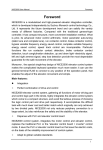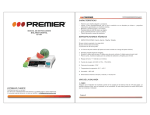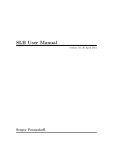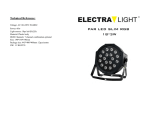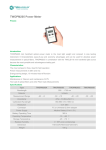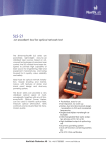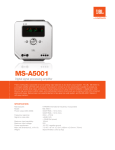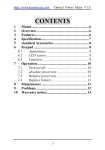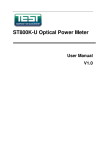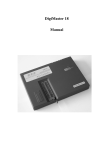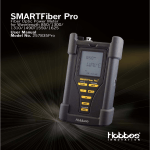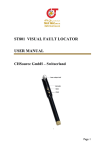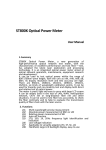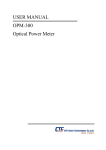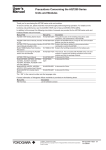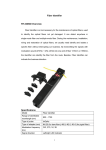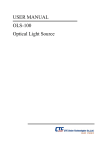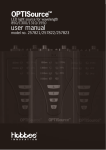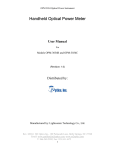Download ST801 Optical Power Multi Meter User Manual V2.0
Transcript
Optical Power Multi Meter User Manual V2.0 Contents I.Summary ...........................................................................1 II.Functions ..........................................................................2 III.Technical Specifications ................................................2 IV.Layout ..............................................................................4 V.Operation..........................................................................5 VI. Maintenance................................................................10 VII. Faults & Solutions .....................................................12 1. Summary Combining optical source and optical power meter in one, Optical Power Multi Meter is a portable and intelligent instrument for optical network test. There are inner 1310nm and 1550nm dual wavelength output optical source. It can fulfill the functions of steady optical source and optical power meter at the same time, and it realizes the loop test and two-way automatic test. Its single-end test solution greatly advances the test efficiency. The inner microprocessor and linearity magnification technology ensure the long time calibration and test accuracy. Optical Power Multi meter can carry out not only the absolute and relative power test, but also the optical loss test for fiber, optical cable and optical passive devices automatically, and it can save test results. It is suitable for construction, maintenance of fiber communication and CATV system; meanwhile, it is used for laboratory test and R&D. It is an ideal portable tool for fiber project staff. II. Functions 1. Multi wavelength exact test 2. Absolute power test for dBm or μW 3. Relative power test for dB 4. Single end for dual wavelength output, free switch from 1310 nm and 1550 nm 5. 200 groups of test data storage and management 6. Multi adapters(FC, SC, ST ,LC) 7. Handheld, large LCD display, easy to operate 8. under voltage indication 9. Auto power off in 10 minutes 10. Auto Backlight off in 60 seconds 11. USB communication 12. With real-time clock function, can real-time display the current time, provide recording time for data storage III . Technical Specifications Ø optical power meter module 1. Wavelength range:800~1600 nm 2. Detector type:InGaAs 3. Optical power test range:-45~+25dBm 4. Uncertainty:±5% 5. Resolution:Linearity display 0.1%, logarithm display 0.01dBm 6. Automatic frequency identification: 270Hz、1KHz、2KHz optical source module 1. Emitter type:FP-LD/DFB-LD 2. Dual wavelength switch function: 1310±20nm, 1550±20nm 3. Spectral line width:≤5nm 4. Output optical power:≥-7 dBm 5. Short-time stability of output optical power: ≤±0.05dB/15min 6. Long-time stability of output optical power:≤±0.1dB/5h Ø Ø Others 1. Low voltage indication:There is indication when battery voltage is lower than 3.4V 2. Time for auto power-off:10 min 3. Working duration for battery: ≥70h (the optical source and optical power meter work synchronously) ≥140h (only optical power meter work) 4. Battery: 3.7V/2500mAh high-performance rechargeable lithium battery 5. Operating temperature:0℃~40℃ Storage temperature:-10℃~+60℃ 6. Weight: 0.2Kg 7. Dimension:160mm×76 mm×28 mm IV.Layout Browse Record Save Record Date and Time Auto Power off Wavelength Optical Auto backlight off Power 1 Optical Power 2 5 4 2 6 1 3 V. Operation Introduction for optical power meter module 1. On/Off key:Pressing On/Off key can open and close the tester. The tester will use the auto power off as default status when you open the tester. Turn off auto power off Ø function: In power-on state, press key and dBm/dB key together, and lift up the two keys simultaneously, you will see automatic power off mark disappear from the screen. Turn on automatic power-off function: In power-on state, press key and dBm/dB key together, and lift up the two keys simultaneously, you will see automatic poweroff mark displayed on the screen. 2. Unit key: The instrument defaults the absolute measurement of optical power. The value displayed by optical power1 means linear power value (nW); The value displayed by optical power2 means logarithmic power value (dBm). Press the dBm/dB key, system will switch to relative power test state. In this case, the value displayed by optical power1 means logarithmic power value (dBm) and the value displayed by optical power2 means relative power value (dB). 3. Wavelength key:You can choose one of four kinds of wavelengths: 850nm, 1310nm, 1550nm and 1625nm through this key. The chosen wavelength will be displayed in the right top corner of the LCD screen. When the instrument is power-on, it defaults the wavelength of 1310nm, and circulates in order of 1310nm, 1550nm, 1625nm and 850nm. 4. Save key:The storage function for current test data can be realized by pressing this key. Storage mark will be displayed on the LCD screen. When the storage mark disappears from the screen, it means data storage is completed. The system can store 200 pieces of records. When the storage groups exceed 200 pieces, it will cover the first piece automatically. 5. Browse key:Press this key, the browse mark will be displayed on the LCD screen, this means the system is in data recall state. The last saved data will be displayed on the LCD screen. Press this key again and the browse mark disappears, the system exits data browse state and returns to normal state. In browse state, press the key“▲”can realize page up browsing function for saved data; Press the key“▼”can realize page down browsing function for saved data. 6. Backlight key: When power-on, the system defaults backlight-on, auto backlight-off mark is displayed on the LCD screen. At the same time auto backlight-off function is open. Pressing this key, backlight is off; pressing this key again, backlight is on. In the state of auto backlight-off, pressing “backlight” key and “wavelength” key together, automatic backlight-off mark disappears from the LCD screen, and the function of auto backlight-off is closed. In the state of auto backlight-off is closed, press “backlight” key and “wavelength” key together, auto backlight-off mark displays on the LCD screen, and the function of auto backlight-off is open. 7. Time check: Press “recall” key and “unit” key together, and lift up the two keys simultaneously, the system enters time check state. Press “store” key and select the time position which will be adjusted, press the key“▲”and “▼”to adjust the selected time position. Press “browse” key and “wavelength” key together and lift up the two keys simultaneously to adjust the time and exit time check state, then enter normal state. 8. Frequency automatic identification: When optical signal has modulation information, the system can identify optical signal of 270Hz, 1KHz, 2KHz automatically. Ø Stable Optical Source Module After the instrument is powered on, the default state of optical source module is in the closed state. In the optical power test state, press “Mode” key, the instrument enters optical source output state. Optical power1 does not display any data while optical power2 displays the modulation mode of the output optical signal: CW, 270Hz,1KHz、2KHz. Enter the optical source output state; no optical signal is output at first. Wavelength of 1310nm and 1550nm can be chosen by press “wavelength” key. After choose a wavelength, modulation mode of the output optical signal: CW 、 270Hz 、 1KHz 、 2KHz can be selected by press“▲”or“▼”. When optical signal is output, backlight mark will shine all the time. Press “Mode” key again, the system will return optical power test state. In this case two modules can work at the same time. Ø Other functions 1. Under voltage indication function: When the voltage of battery is under 3.4V, the sign will be displayed on the LCD screen, the battery should be charged at once. 2.Battery charge: During the operation period, if under voltage sign appearances, please power off the instrument and charge the battery by using relative charger. The indication light of charger is red when it is in charge, and it will be green when it is full of voltage. 3.Data communication function By using WINDOWS hyper terminal software, baud rate is 19200, data bits is 8 bits, stop bits is 1 bit, no parity bit, no flow control, send commands according to the following table, you can operate ST801 accordingly. Character Sent Instructions Table: Instruction Instruction name word Menu M Function Pick Remark up and read Sent main instructions: M instructions: D instructions: H ENTER menu Real-time D test History H record Time check T nn/yy/rr Real-time Sent power display ENTER Recall Sent history record ENTER Set time A space between date and hh:mm:ss time For example: 09/01/05 11:15:00 Sent instructions : T 09/01/05 11:15:00 ENTER Wavelength Ln set Test mode Fn Set wavelength Sent n 0-5 ENTER Set test mode Sent instructions: L instructions: F ENTER Hexadecimal Sent Instructions Table: Instruction Instruction name word Menu 4D Function Pick up Remark and Sent instructions:4D 0D read main menu Real-time 44 test History Wavelength Sent instructions:44 0D power display 48 record Time check Real-time Recall history Sent instructions:48 0D record 54 20 xx xx Set time For example: 2F xx xx 2F 09/01/05 11:15:00 xx xx 20 xx Sent instructions: xx 3A xx xx 54 20 30 39 2F 30 31 2F 30 35 3A xx xx 0d 20 31 31 3A 31 35 3A 30 30 0d 4C set Set wavelength Sent instructions:4C 20 33 0D n 0-5 Test mode 46 Set test mode Sent instructions:46 20 30 0D VI. Maintenance 1. The instrument should be avoided to shock, hit, fall off and other mechanical damage. Meanwhile, it should be avoided to touch acid, alkali and other harmful matters. 2.To keep the photoelectric sensor interface and laser connector interface clean; do not use dirty or non standard adaptor tie-in; do not insert the bad polished interface, otherwise, the sensor interface and laser interface will be damaged. Please clean the fiber jump line ceramic core interface using absorbent cotton and alcohol before it is operated. After the alcohol is dry then you can use the instrument. 3.When you use different kinds of adapter to test, please screw the FC type adapter of the photoelectricity sensor and then insert the ceramic core of different adapter into the photoelectricity sensor to test. Please keep the FC type adapter, which is screwed carefully to avoid the dust. After the test, the FC type adapter should be screwed again. 4. Please cover the dust proof cap of photoelectricity sensor and laser connector when the instrument is not operated for a long time, to keep it clean and avoid the test error caused by circs, that the sensor and laser connector uncovered in the air for a long time. 5. To clean the sensor and laser connector interface regularly to ensure the veracity of test result. 6. Please take the battery out if it is not used for long time to avoid the effect for battery life. Notice: When the instrument is being operated, it is forbidden that the eyes look at the output end of laser instrument directly, or the eyes or skin is likely to be burnt by the laser. VII . Faults & Solutions Faults Dark Reasons LCD Low voltage of battery display Solutions Charge the battery Big test error Dirty sensor interface Clean the sensor interface Nothing displayed power on Low voltage in battery/others after Power on again or charge the battery Notice: Optical power multi meter defaults wavelength of 1310nm when it is open. The instrument has four wavelength calibration points: 1310nm, 1550nm, 1625nm, 850nm. Press “wavelength” key, and the wavelength circulates in order of 1310nm, 1550nm, 1625nm and 850nm. When you choose a six wavelength optical power multi meter, it has six wavelength calibration points: 1310nm, 1490, 1550nm, 1625nm, 850nm and 1300nm. Press “wavelength” key, and the wavelength circulates in order of 1310nm, 1490nm, 1550nm, 1625nm, 850nm and 1300nm.















